We use cookies to ensure that we give you the best experience on our website. If you continue without changing your settings, we will assume that you are happy to receive all cookies on the Business Car website. However, if you would like to, you can change your cookies at any time

The start point for the best source of fleet information |
Final report: Skoda Kodiaq long-term test
Date: 17 May 2023 | Author: Richard Bush
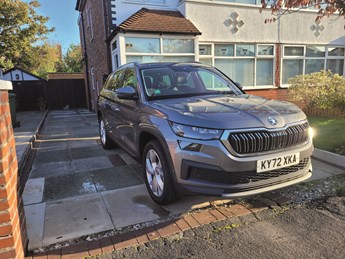
|
|
||||||||||||
Final Report: Bonus content
I am coming to the end of my time with the Kodiaq - and after 4,000 miles - I thought it would be interesting to get more granular with the car's settings.
With many driver assist, media and navigation features being seamlessly automated nowadays, you can easily find yourself jumping behind the wheel of a car and barely interacting with any physical buttons or settings. That was certainly the case when I hopped into the Kodiaq. In fact, I didn't even realise the touchscreen had a main menu until about two months later - and I'm yet to touch the clever auto climate control after six months.
Cars are designed this way to minimise distractions and make life easier. But out of curiosity, I dedicated some driveway time to noodling about with some buttons.
Perhaps the most significant built-in feature I've overlooked is the Park Assist function. This self-parking feature was a big gimmick a few years ago, but it's now a staple of small and large cars everywhere. Park Assist allows for semi-automated parking, with the car adjusting the steering - and you controlling the throttle and gears. With help from sensors and cameras, the car will identify a parking space and take you step-by-step through the process of parking. I used this twice in the Kodiaq - and it works fine - but I still think learning how to properly park yourself is simpler.
I was surprised at the amount of tweaking that was available for everyday features like central locking, lights and mirrors. For example, you can specify if you want the doors to automatically lock when you start driving, or whether you want the car to automatically open when you pull the handle with the key in your pocket. You can also set the duration of the follow-me-home headlights, set the mirrors so they point down towards the curb when reversing, and even deactivate the rain-sensing wipers.
You also get equaliser settings in the sound menu, so you can position sound waves in the car more accurately - and you can adjust other volume settings here too, like automatic speed-dependent volume adjustment and how much your music will reduce when executing parking manoeuvres.
One seemingly useless feature - but I'd argue rather nifty - is the ability to adjust the brightness of interior lighting, including ambient lighting, screen brightness and even the brightness of the lights in the footwells. This is unlikely to be listed on any spec-sheet, but for those that like their cars to feel individual to them, it's not to be sniffed at. There are individual user profiles too, so if you and your partner like things set up a different way, it is ideal.
An arguably more useful everyday feature is the ability to adjust the distance sensitivity of the front assist alert - which gives an audible warning for oncoming obstacles, like cars slamming on their brakes in front of you. This can be set to early, medium, late or off. If you tackle long motorway journeys infrequently, this setting could come in very handy.
There are features that you probably won't use, like gesture controls for the touchscreen - which are less hit and more miss - and the various driving modes which don't offer much value outside of slightly modifying your throttle response.
As mentioned in previous reports, the Kodiaq is a solid, all-round family car, and there is very little to moan about with it. A few more efficient engines? Maybe, but that can be said for a lot of big SUVs - and an average of around 40mpg is still pretty good. The Kodiaq is certainly a car that's been designed with families in mind, and it's all the better for it.
6th Report: A bit of perspective
Jumping in and out of different cars every week can leave you a bit discombobulated at times - to the point where interior designs, driving dynamics and powertrain set-ups all mush into one.
I had an interesting experience recently however where I drove a luxury SUV that didn't meet my expectations. The car in question was the Mazda CX-60, the Japanese brand's first attempt at creating a sporty, but luxurious, SUV poised to take on the likes of BMW and Audi.
To be clear, I don't dislike the CX-60 - its practicality is excellent and its interior is gorgeous - but its drive misses the mark for me. Mazda has tried to achieve an engaging, sports-infused character, albeit with comfort levels that suggested an aura of opulence. I didn't feel that these qualities spliced together successfully. Instead, it felt unsure of itself and failed to convincingly plant a flag in either camp.
This brings me to the Kodiaq. As the Kodiaq is my current daily driver, it naturally becomes the yardstick that I use to compare any other car I drive to - be it a city car, saloon, estate or SUV. After I'd driven the CX-60 and jumped back in the Kodiaq, I was taken aback by how much I preferred the Kodiaq's drive.
Just pulling off my driveway and turning the wheel 90 degrees made me literally gasp at how different the Kodiaq felt to the CX-60 - a car that was supposed to be finely tuned to offer stand-out dynamics and comfort. I'm not bashing the CX-60 - there are tons of cars on the market that try something, and it doesn't quite work, or simply over-engineer their cars to the point where driving them feels like an exhaustive arcade driving simulator. The Kodiaq just feels so much. easier.
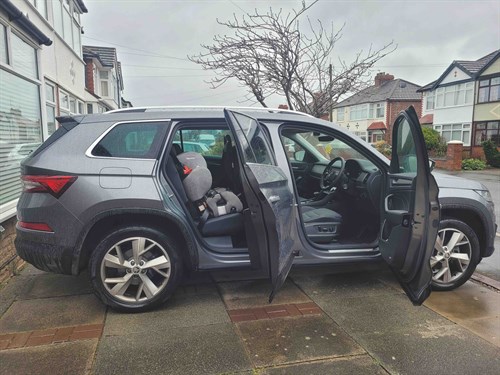
The Kodiaq's drive isn't supposed to be particularly notable in any way; fun, engaging or uber-comfortable. It's engineered to make school runs and supermarket shops simple and predictable. However, it's those exact qualities that encourage a sigh of relief every time I drive it.
If you're someone who likes to take the long, winding, B-road route home, then the Kodiaq's sensible drive might not be for you. But for rocking around with a two-year-old and dog in tow, it works a treat for me.
It's funny actually, this ordeal reminded me of the 2016-reg SEAT Leon I used to own - bear with me. I would drive this in between weekly test cars, and more often than not, I would prefer the way the SEAT drove to anything else. This was for very similar reasons to the Kodiaq - and I'm not surprised; both cars belong to the VW Group, both are based on the same MQB platform, and both are designed with a similar ease-over-entertainment steering and suspension set-up. The exact same can be said for the VW Group's posterboy, the Golf, too.
So what does all this mean? Well, there is certainly a place for more "specialised" cars on the market. And by specialised, I'm talking about cars that go above and beyond the benchmarks of comfort and sportiness. If that's what you're after, then go for it.
But if you're trying to find a car to suit a domestic lifestyle, there's no need to complicate things - go for something like the Kodiaq. Nowadays, there's a real danger of browsing the buffet of car options and ultimately compromising with something that's not quite right. So, why not just go with a set menu you know you're going to be happy with?
5th Report: Engine Czech
I've clocked up around 2,000 miles in the Kodiaq since it arrived - and overall, there isn't much I don't like about it. But, like most cars, there are certain lifestyle choices that will dramatically affect whether it will work for you or not. One aspect of the Kodiaq I've been scratching my head about is its engine pairing and fuel economy figures.
From the get-go, I knew the 1.5-litre 150hp petrol engine in the big, seven-seat Kodiaq wasn't going to return amazing fuel economy figures. And although I don't feel like I'm filling up all that often, the average mpg readout on the dashboard has been raising an eyebrow or two.
The current long-term mileage figure reads 29mpg. The vast majority of my journeys however are short stints, many of which are in rush-hour traffic or busy urban environments. In fact, a recent 8am rush-hour trip, lasting one hour, resulted in an average of 23mpg. That included a lot of stop-start queues and traffic lights.
Does that mean the 1.5-litre TSI Kodiaq is "bad" when it comes to fuel economy? Well, not necessarily. During cross-country motorway journeys I have consistently achieved an average of around 40mpg. Given the size of the Kodiaq and its 1.5-litre unit, I'd say that's pretty good.
Admittedly, I don't drive particularly eco-consciously. However, with a baby in the backseats, I don't drive erratically either. I actually found that when taking a bit of extra time, squeezing the accelerator gently and leaving plenty of time to slow down at lights and pull out at junctions, I managed to boost my average urban mpg to around 35mpg - which is a bit more manageable.
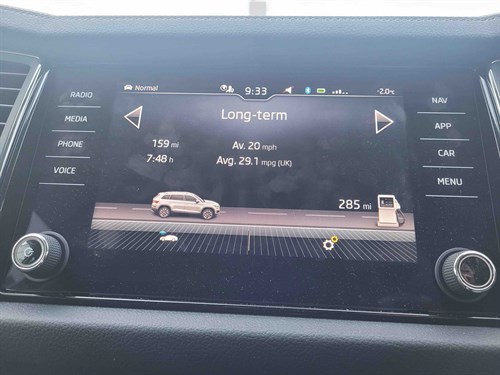
I can't help but feel the DSG automatic gearbox is hindering the Kodiaq's efficiency though, especially with the way it bounces the revs when leaving junctions and pulling off overtakes. It can be hesitant to respond in said scenarios as well, which is frustrating if nothing else. Would I give up the convenience of an automatic gearbox for slightly improved fuel economy and the ability to complete manoeuvres with added ease, however? No, probably not.
In a nutshell, so long as you don't exclusively use the Kodiaq to commute like a footballer through central London, you should be okay. Of course, you can always look at the Kodiaq's 2.0-litre 150hp diesel which claims an average return of 50.4mpg for greater all-round fuel economy. If diesel is your thing, that is.
The engine pairing probably is the only head-scratcher with the Kodiaq - and I will staunchly defend pretty much every other aspect of it, especially its practicality. When heading out with our two-year-old child and dog, we would usually have to shift things around significantly to accommodate both the dog crate and the pram. That's not the case with the Kodiaq, mainly because of the vast footwell room on offer in the back seats.
With this, we can stand the pram upright, keep its dirty wheels off the seats, and free up boot space for the hound. And because of the square shape of the boot floor, the dog crate stays firmly in place, and can even be folded flat and left in the boot for shopping to go on top of it.
The fact that the automatic boot lid requires just a foot of space to swing all the way open, further adds to its canine-friendliness. The limited, but usable, underfloor boot storage space in the Kodiaq is handy for quickly accommodating unplanned cargo as well, such as small shopping bags, jackets and boots.
4th Report: The cold Skoda
We are seemingly incapable of handling the ice, wind, rain and snow that accompanies the winter months here in blighty. Our road network all but falls to bits, supermarket journeys become a military operation and spotting a gritter on the road is about as rare as catching Santa noshing on a mince pie.
With all that in mind, it doesn't hurt to have a solid set of wheels to help alleviate some of the festive stress. The snowfall has been particularly extensive this December, which has given us a great opportunity to assess our Kodiaq loaner and how it handles cold
wintery mornings.
Typically, if it's been a frosty night, I'll head outside around half an hour before leaving the house to assess just how frozen the windscreen of whatever I'm driving is. But our Kodiaq SE L Executive has made me a bit cocky. I've found myself heading out to turn the engine on and clear the windscreen just five minutes before leaving.
The heated windscreen - which is set to come on automatically - is predominantly what makes this possible. I'll usually start the engine, whack the defog on full blast for the front and back windows, then shift any snow and ice off the outside of the windscreen with the included ice scraper stashed in the fuel flap - this feature never fails to give me childish joy. The included Skoda-branded umbrellas hidden in the driver and passenger doors are a devilishly convenient feature too.
When combined with the aforementioned heated windscreen feature, I can usually have the car defrosted and ready to go in five to ten minutes, regardless of what tundra has occurred the night before. It's brilliant. I've actually jumped straight in and simply waited for the car to thaw itself a few times, it's that fast.
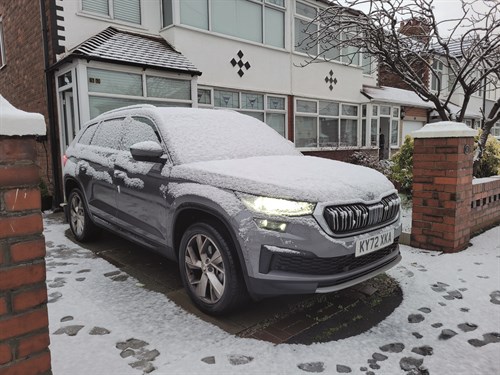
The heated windscreen feature comes courtesy of Skoda's Winter Pack, which is a £520 optional extra. The Winter Pack also adds a heated steering wheel, heated windscreen washer nozzles and heated front seats - although the latter are standard on SE L Executive models, irrespective of whether you go for said Winter Pack. Electrically-adjustable, heated door mirrors are standard across the Kodiaq range too, although I haven't actually felt the need to activate them in our Kodiaq - yet.
The heated seats in the Kodiaq are particularly impressive as they heat up fast and manage to maintain a consistent not-too-hot, not-too-cold temperature for an infinite amount of time - something that's less common than you'd think.
The auto climate control feature works a treat, too. Since we've been driving it, it's been set to 21/22°, and I haven't touched it. Regardless of whether it's hot or cold outside, it acclimatises quickly and effectively, every time. This is great for keeping the whole family happy, especially my two year old who refuses to wear a hat and gloves.
The heated steering wheel is slightly less impressive as it only really tends to heat the top half of the steering wheel, forcing you to drive like a granny holding a handbag.
In terms of actually driving in ice and snow, our 1.5-litre TSI Kodiaq distinctly lacks four-wheel drive, which is reserved for the 2.0-litre TSI and 2.0-litre TDI variants. This means that it's prone to skidding on ice if you don't drive slowly. although that can be said for any two-wheel drive car. The chunky wheels and raised ground clearance has certainly helped with traversing verges of plowed snow however.
The DSG automatic transmission is standard across the Kodiaq range, and in treacherous, snowy conditions, it can lack a little finesse when edging out of junctions, with input either being delayed and causing you to roll back, or conversely - when in Sport mode - sending you into a small wheel spin due to the hyper-sensitive throttle response. I still think an auto 'box is the better all-round option in the Kodiaq though - and there isn't a manual option anywhere in the range anyway.
3rd Report: Practically, almost perfect
With the weather getting colder, and the days getting shorter, the past few months have been all about tackling in-home DIY tasks. And as a result, I've become very well acquainted with the Kodiaq's boot.
A boot's capacity on paper can be very different to what it's like in the real world. Bulging wheel arches, high load lips, angled seats and dodgy parcel shelves can all result in less than magnificent wiggle room.
Skoda has always managed to have a good grasp of what car owners like and want in a boot however. The seven-seat Kodiaq for example - while featuring two seats stashed in the rear - still manages to offer that coveted square floor plan in its cargo area. The kind of shape that you can meticulously organize shopping bags in, by pushing them right into the corners. The seats fold down flat too and give you a nice long load bed for things like planks of wood and - in my case - a vast amount of bathroom tiles. So for DIY, it's spot on.
You even get additional storage space situated just before each wheel arch, where the square shape of the boot fans, giving you two tiny cubbies for breakdown essentials, or simply some little nooks to nestle your takeaway. You get two fold down bag hooks near these mini cubbies too.
While the wheel arch bulges aren't completely masked, they do at least serve a practical purpose, housing cup holders for those sat in the rearmost seats.
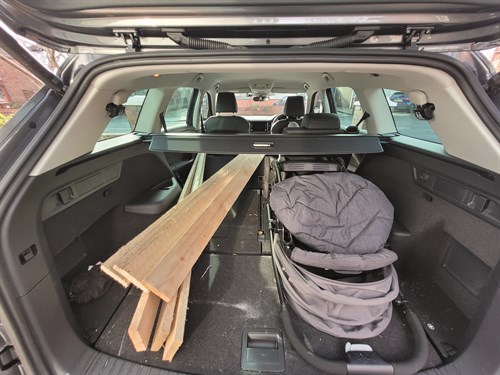
When it comes to actual stats, the seven-seat Kodiaq has 270 litres of space with all seats in place, 560 litres when you fold the furthest row down, and 765 litres with the middle row down. As mentioned, these stats aren't everything. And you won't find the Kodiaq's wide boot opening and virtually nonexistence load lip anywhere on a spec sheet.
A seemingly small - but I would argue rather major - boon of the boot is the fact that the parcel shelf neatly tucks under the boot floor, with a groove carved out to ensure it slots right into place. Storage under the boot floor isn't really good for much else, due to the full size spare taking up most of the space, but you can still get away with stuffing a few shopping bags in.
Although the boot lid of the Kodiaq looks rather intimidating in size, it actually only requires about a foot of space behind to fully open, which for my driveway - and every car park in the UK - is a massive plus.
The Kodiaq isn't perfect though. It would have been nice to have some quick release levers in the boot to fold the middle row down. These are a £100 option and not standard on any five or seven seat Kodiaq. Folding the middle row flat can be a bit of a faff as well, due to the sliding mechanism - which facilitates passengers climbing into the rearmost seats - wanting to kick in and send the seat forward rather than down. These are only minor shortcomings however.
Nipping back and forth to B&Q and the local tip has also made me appreciate the Kodiaq's small, but effective, cabin practicalities. The door bins for example can easily swallow a chunky one liter gym bottle - and the center console features a completely removable cup and spare change organiser. And of course, let's not forget about the stacked glovebox, which features a van-like configuration with an additional glovebox built into
the dashboard.
Every cabin storage cubby has been stuffed with all manner of receipts and wrappers, and the Kodiaq hasn't missed a beat. Just got to finish the bathroom now.
2nd Report: All the trimmings...
I threw the Kodiaq in the proverbial deep end last month, taking it on two long distance trips the day after it was delivered. That gave me some great time on the road with it, but not much button-prodding driveway time. I've since found some time to do just that.
Skoda updated its trim level line up this year, tweaking some of the grade names and sprinkling some new kit about the place. Notable name changes include SE L Executive (previously SE L) and SE Drive (previously SE).
The model we have is the SE L Executive. The outgoing SE L equipment grade was already pretty extensive, and arguably represented the best sweet spot in the Kodiaq range thanks to its various engine options and integral tick boxes of tech. Skoda has built on it however with the SE L Executive trim which now adds 19" Cursa alloys, a reversing camera, full leather upholstery, electrically-adjustable, heated and folding door mirrors - with an auto-dimming driver's side mirror - and an electrically adjustable driver's seat with memory function.
After recently driving the outgoing SE L Kodiaq, I can confidently say that the SE L Executive grade does feel noticeably swankier. The full leather upholstery has been a welcome addition, especially when it comes to wiping them clean after our messy two-year-old. The reversing camera has helped me manage the heft of the seven-seat Kodiaq too, and has been particularly life-saving in tight parallel parking situations. And I've ended up using the driver's seat memory function more than I thought I would. With my wife occasionally jumping behind the wheel, she usually ends up making seating adjustments that ultimately leave us both with undesirable seating positions. This is no longer the case. And it makes heading off the driveway in a rush quicker, too.
Aside from the new additions, our SE L Executive model has tonnes of other handy kit as well, including a slick 8in infotainment screen with sat-nav, Android Auto and DAB radio, cruise control and front and rear parking sensors. The Android Auto system can be a bit fiddly to connect at first - and when disconnected it will do everything in its power to re-establish a connection, even if that means stopping you using your actual phone. But all things considered, it works fairly seamlessly, and being able to browse Spotify and Google Maps on the car's touchscreen is a massive plus.
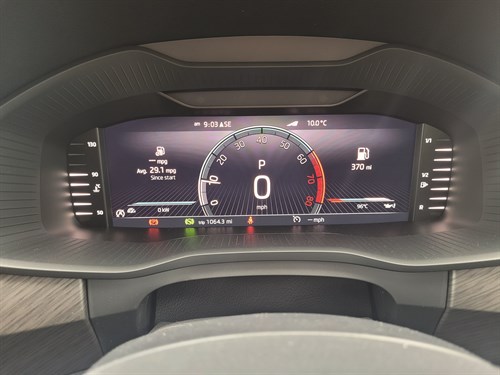
It's got to be said though, the best thing about the Kodiaq's cabin is its virtual cockpit. This is a £420 optional extra and it gets you a digital instrument cluster behind the steering wheel. If you only splurge on one add-on, I'd make it this. It's night and day compared to the analog dial set-up, and it's able to deliver quick-glance readouts of speed, fuel economy and maps. Not opting for the virtual cockpit somehow manages to age the car's interior by about five years.
The overall feel of the Kodiaq's cabin is solid. In typical Skoda fashion, it manages to maintain its comfortable, practical character, no matter what kit you throw at it. It never feels like it's trying to juggle too much tech. The centre console features an adjustable armrest, there's easy-to-access climate control buttons, there's a place to store your phone and wallet, a glovebox below and on top of the dashboard, and the door bins will even swallow a chunky one litre gym bottle.
The Kodiaq's cabin doesn't necessarily feel "special" in terms of luxury or style, but that's not why you buy a Skoda. It skirts ostentatiousness, but still manages to offer pretty much everything you'd want or ever need - especially from a family point of view.
1st Report: To Scotland!
When gathering my thoughts and first impressions on a car, I usually like to ease into things slowly. Dip my toe. Go for a leisurely cruise to the shops and back. With the Skoda Kodiaq I recently acquired, however, that wasn't possible. The day before I was scheduled to head from Liverpool to Glasgow to take part in the Great Scottish Run - with three adults and a baby in tow - the Kodiaq arrived. So, my first experience of this particular Kodiaq involved frantically loading the car up with luggage, and deciding where everyone was going to sit.
Seven seaters typically have fairly disappointing boots, with all seats in place, that is. The Kodiaq however has enough space to fit a baby's pram and a few rucksacks fairly easily - freeing up the back row of seats for another passenger. My wife sat in the rearmost seats and, after sliding the middle bench forward a few inches, she commented on how comfortable the 3.5 hour drive was, with just enough space to make it feel like a regular seat.
This of course meant that leg room in the middle row was slightly compromised, but not enough to go noticed by my mother-in-law. It's worth noting that the Kodiaq's middle bench is split-folding 60/40 - so although the seats were moved forward on one side, my two-year-old could enjoy maximum leg room on his side.
![20221001_071431[58]](/media/3771425/20221001_071431_58__500x375.jpg)
The second I jumped behind the wheel of the Kodiaq I was a little shocked by how big it felt. I've just come off the back of driving a five-seat Skoda Enyaq for several months, so I didn't think the Kodiaq would feel much different - but it does. It's not daunting by any means, but it certainly feels like a seven-seater. The driving position in the Kodiaq is very comfortable, with the door sill being just the right height to mount your elbow, and the centre armrest being adjustable for height.
I'm still undecided on whether the combination of its 1.5-litre 150hp petrol and seven-speed DSG automatic is a triumph or not. Although great when breezing along in cruise control, it can feel overworked when completing overtakes at times and can be hesitant to change down a gear.
With a car full of passengers, I was keen to keep manoeuvres as smooth as possible, so I was admittedly very gentle with the accelerator. That, combined with the fact that I had it in "Eco" mode the whole journey, might explain the slightly lackadaisical powertrain characteristics, so I'll be sure to fiddle about with the driving modes on my next motorway stint and see if it improves things.
The built-in sat-nav in the Kodiaq is a little slow to react at times, especially when approaching motorway slip roads, which can be a bit disconcerting on unfamiliar roads. I quickly resorted to using Android Auto however, with its integration of Google Maps and Spotify being faultless.
With most of Glasgow city centre in lockdown, with road closures everywhere due to the Great Scottish Run, navigating the twisty outskirts of the city was a bit of a challenge, especially given the Kodiaq's seven-seater size. But it handled itself well, even in the tight Q Park multi-storey we were forced to park in.
Over each 210-mile stint of the journey I averaged 40mpg - and that was based on a solid average cruising speed of 65mph. The Skoda spec sheet reckons you'll get between 37.7mpg and 39.2mpg - so considering I had a car full of passengers and luggage, I'll take it.
So far, I'm pretty happy with the Kodiaq, although I'm keen to see how it performs when I'm driving solo with less luggage loaded up in the back. And I'd like to see how it handles busy urban work traffic and Saturday morning supermarket sweeps.
Oh, and yes, it did get me to the Great Scottish Run in time, and I was pretty happy with my 1.48.47 completion time too - not that you asked.











